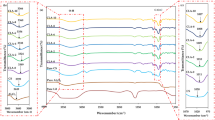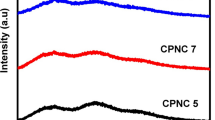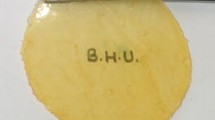Abstract
A proton-conducting biopolymer electrolyte system based on corn starch doped with 0.0 to 4.0 wt% of Al(OH)3 has been prepared through the solution casting method. Scanning electron microscopy and confocal micrographs showed a partial alteration of starch granule boundary and aluminum agglomerates formation as a function of the Al(OH)3 concentration. X-ray diffraction and Fourier transform infrared spectra showed a decrease in the relative crystallinity and in the absorbance ratio 1047/1022, associated with the disruption of double-helix structures and the region of starch granule disorder, in concordance with the C1 and C4 deconvoluted curves obtained by CP/MAS 13C-NMR. Furthermore, corn starch films (CSF) mostly showed AlO5 (pentahedral) and AlO6 (octahedral) species as a function of the Al(OH)3 concentration, associated with a suitable Al3+ distribution through the CSF arrangement obtained by CP/MAS 27Al-NMR. Particularly, CSF with 2.0 wt% of Al(OH)3 showed 27.5 F g−1 of specific capacitance and 7.5 mS cm−1 of electrical conductivity values, using voltammetry cyclic and the van der Pauw four-point test, respectively. The electrochemical behaviour of CSF was occasioned by saturation limit of chemical bonds between the functional groups into the starch molecule and the Al3+ ions was achieved, this disarrange and/or bankrupt the sequence of CSF microstructure, caused by the coexistence of free Al3+ ions and aluminum agglomerates. All these results implied that the present proton-conducting biopolymer electrolyte system based on corn starch–Al(OH)3 has the potential to be applied in electrochemical devices.









Similar content being viewed by others
References
Buléon A, Colonna P, Planchot V, Ball S (1998) Starch granules: structure and biosynthesis. Int J Biol Macromol 23:85–112. https://doi.org/10.1016/S0141-8130(98)00040-3
Demirgöz D, Elvira C, Mano JF, Cunha AM, Piskin E, Reis RL (2000) Chemical modification of starch-based biodegradable polymeric blends: effects on water uptake, degradation behavior and mechanical properties. Polym Degrad Stabil 70:161–170. https://doi.org/10.1016/S0141-3910(00)00102-6
Dumoulin Y, Cartilier LH, Mateescu MA (1999) Cross-linked amylose tablets containing-amylase: an enzymatically controlled drug release system. J Control Release 60:161–167. https://doi.org/10.1016/S0168-3659(99)00065-6
Pifferi G, Santoro P, Pedrani M (1999) Quality and functionality of excipients. Il Fármaco 54(1–2):1–14. https://doi.org/10.1016/S0014-827X(98)00101-3
Rodrigues A, Emeje M (2012) Recent applications of starch derivatives in nano drug delivery. Carbohydr Polym 87:987–994. https://doi.org/10.1016/j.carbpol.2011.09.044
Liew CW, Ramesh S, Ramesh K, Arof AK (2012) Preparation and characterization of lithium ion conducting ionic liquid-based biodegradable corn starch polymer electrolytes. J Solid State Electrochem 16:1869–1875. https://doi.org/10.1007/s10008-012-1651-5
Gupta S, Varshney PK (2019) Effect of plasticizer on the conductivity of carboxymethyl cellulose-based solid polymer electrolyte. Polym Bull 76:6169–6178. https://doi.org/10.1007/s00289-019-02714-1
Fuzlin AF, Samsudin AS (2021) Studies on favorable ionic conduction and structural properties of biopolymer electrolytes system-based alginate. Polym Bull 78:2155–2175. https://doi.org/10.1007/s00289-020-03207-2
Shukur MF, Ithnin R, Kadir MFZ (2014) Electrical properties of proton conducting solid biopolymer electrolytes based on starch-chitosan blend. Ionics 20:977–999. https://doi.org/10.1007/s11581-013-1033-8
Bertoft E (2017) Understanding starch structure: recent progress. Agronomy 7(3):56. https://doi.org/10.3390/agronomy7030056
Finkenstadt VL, Willett JL (2004) Electroactive materials composed of starch. J Polym Environ 12:43–46. https://doi.org/10.1023/B:JOOE.0000010049.33284.08
Jeong H, Baek S, Han S, Jang H, Kim SH, Lee HS (2018) Novel eco-friendly starch paper for use in flexible, transparent, and disposable organic electronics. Adv Funct Mater 28(3):1704433. https://doi.org/10.1002/adfm.201704433
Whistler RL (1984) Chapter I—history and future expectation of starch use, starch: chemistry and technology (second edition). J Food Sci Tech. https://doi.org/10.1016/B978-0-12-746270-7.50007-0
Ashogbon AO, Akintayo ET (2013) Recent trend in the physical and chemical modification of starches from different botanical sources: a review. Starch/Stärke 66:41–57. https://doi.org/10.1002/star.201300106
Palacios-Fonseca AJ, Castro-Rosas J, Gómez-Aldapa CA, Tovar-Benítez T, Millán-Malo BM, del Real A, Rodríguez-García ME (2013) Effect of the alkaline and acid treatments on the physicochemical properties of corn starch. CyTA J Food 11:67–74. https://doi.org/10.1080/19476337.2012.761651
Pineda-Gómez P, Coral DF, Ramos-Rivera D, Rosales-Rivera A, Rodríguez-García ME (2011) Thermo-alkaline treatment. A process that changes the thermal properties of corn starch. Procedia Food Sci 1:370–378. https://doi.org/10.1016/j.profoo.2011.09.057
Yeh TS, Liu YT, Liou PJ, Li HP, Chen CC (2016) Investigation of aluminum content of imported candies and snack foods in Taiwan. J Food Drug Anal 24:771–779. https://doi.org/10.1016/j.jfda.2016.04.004
Willhite CC, Karyakina NA, Yokel RA, Yenugadhati N, Wisniewski TM, Arnold IM, Momoli F, Krewski D (2014) Systematic review of potential health risks posed by pharmaceutical, occupational and consumer exposures to metallic and nanoscale aluminum, aluminum oxides, aluminum hydroxide and its soluble salts. Crit Rev Toxicol 44(S4):1–80. https://doi.org/10.3109/10408444.2014.934439
Brinker CJ, Scherer GW (1990) Chapter 13-film formation, sol–gel science: the physics and chemistry of sol–gel processing. Academic Press , Cambridge, pp 786–837 (ISBN: 9780080571034)
Li X-B, Yan L, Zhao D-F, Zhou Q-S, Liu G-H, Peng Z-H, Yang S-S, Qi T-G (2013) Relationship between Al(OH)3 solubility and particle size in synthetic Bayer liquors. Trans Nonferrous Met Soc China 23(5):1472–1479. https://doi.org/10.1016/S1003-6326(13)62619-9
Franks GV, Gan Y (2007) Charging behavior at the alumina–water interface and implications for ceramic processing. J Am Ceram Soc 90(11):3373–3388. https://doi.org/10.1111/j.1551-2916.2007.02013.x
Khiar ASA, Arof AK (2010) Conductivity studies of starch-based polymer electrolytes. Ionics 16:123–129. https://doi.org/10.1007/s11581-009-0356-y
Gusev GV (1978) Hermans-Weidinger X-ray diffraction technique for determining polymer crystallinity and the use of the Ruland ratio. Polym Sci USSR 20(5):1295–1297. https://doi.org/10.1016/0032-3950(78)90270-8
Cameron D, Moffatt D (1984) Deconvolution, derivation, and smoothing of spectra using fourier transforms. J Test Eval 12(2):78–85. https://doi.org/10.1520/JTE10701J
Mutungi C, Passauer L, Onyango C, Jaros D, Rohm H (2012) Debranched cassava starch crystallinity determination by Raman spectroscopy: correlation of features in Raman spectra with X-ray diffraction and 13C CP/MAS NMR spectroscopy. Carbohydr Polym 87:598–606. https://doi.org/10.1016/j.carbpol.2011.08.032
Buttrose MS (1960) Submicroscopic development and structure of starch granules in cereal endosperms 1. J Ultrastruct Res 4(3–4):231–257. https://doi.org/10.1016/S0022-5320(60)80021-4
Roskhrua P, Tran T, Chaiwanichsiri S, Kupongsak S, Pradipasena P (2014) Physicochemical properties of thermal alkaline treated pigeonpea (Cajanus cajan L.) flour. Food Sci Biotechnol 23(2):381–388. https://doi.org/10.1007/s10068-014-0053-0
Xu A, Seib PA (1993) Structure of tapioca pearls compared to starch noodles from mung beans. Cereal Chem 70(4–6):463–470 (ISSN : 0009-0352)
Dewettinck K, Messens W, Deroo L, Huyghebaert A (1999) Agglomeration tendency during top-spray fluidized bed coating with gelatin and starch hydrolysate. LWT Food Sci Technol 32(2):102–106. https://doi.org/10.1006/fstl.1998.0507
Olivato JB, Grossmann MVE, Bilck AP, Yamashita F (2012) Effect of organic acids as additives on the performance of thermoplastic starch/polyester blown films. Carbohydr Polym 90:159–164. https://doi.org/10.1016/j.carbpol.2012.05.009
Buléon A, Gallant DJ, Bouchet B, Mouille G, D’Hulst C, Kossmann J, Ball JS (1997) Starches from A to C (Chlamydomonas reinhardtii as a model microbial system to investigate the biosynthesis of the plant amylopectin crystal). J Plant Physiol 115:949–957. https://doi.org/10.1104/pp.115.3.949
Mondragón M, Bello-Pérez LA, Agama E, Melo A, Betancur-Ancona D, Peña JL (2004) Effect of nixtamalization on the modification of the crystalline structure of maize starch. Carbohydr Polym 55:411–418. https://doi.org/10.1016/j.carbpol.2003.11.006
Altayan MM, Ayaso M, Darouich TA, Karabet F (2021) Correction to: the effect of increasing soaking time on the properties of premixing starch–glycerol–water suspension before melt-blending process: comparative study on the behavior of wheat and corn starches. Polym Bull 78:1753–1754. https://doi.org/10.1007/s00289-020-03159-7
Pang SC, Tay CL, Chin SF (2014) Starch-based gel electrolyte thin films derived from native sago (Metroxylon sagu) starch. Ionics 20:1455–1462. https://doi.org/10.1007/s11581-014-1092-5
Wang L, Liu F, Wang A, Yu Z, Xu Y, Yang Y (2016) Purification, characterization and bioactivity determination of a novel polysaccharide from pumpkin (Cucurbita moschata) seeds. Food Hydrocoll 66:357–364. https://doi.org/10.1016/j.foodhyd.2016.12.003
Wang SL, Johnston CF (2000) Assignment of the structural OH stretching bands of gibbsite. Am Miner 85(5–6):739–744. https://doi.org/10.2138/am-2000-5-612
Lopez-Cordoba A, Deladino L, Martino M (2013) Effect of starch filler on calcium alginate hydrogels loaded with yerba mate antioxidants. Carbohydr Polym 95:315–323. https://doi.org/10.1016/j.carbpol.2013.03.019
Karim AA, Norziah MH, Seow CC (2000) Methods for the study of starch retrogradation. Food Chem 71(1):9–36. https://doi.org/10.1016/S0308-8146(00)00130-8
Lobato-Calleros C, Hernandez-Jaimes C, Chavez-Esquivel G, Meraz M, Sosa E, Lara VH, Alvarez-Ramirez J, Vernon-Carter EJ (2015) Effect of lime concentration on gelatinized maize starch dispersions properties. Food Chem 172:353–360. https://doi.org/10.1016/j.foodchem.2014.09.087
Skibsted L, Risbo J, Andersen M (2010) Chemical deterioration and physical instability of foods and beverages. Woodhead Publishing Series in Food Science, Technology and Nutrition, 824. eBook ISBN: 9781845699260
Babuk VA, Vasilyev VA (2002) Model of aluminum agglomerate evolution in combustion products of solid rocket propellant. J Propuls Power 18(4):814–823. https://doi.org/10.2514/2.6005
Flores-Silva PC, Roldan-Cruz CA, Chavez-Esquivel G, Vernon-Carter EJ, Bello-Perez LA, Alvarez-Ramirez J (2017) In vitro digestibility of ultrasound-treated corn starch. Starch-Stärke 69(9–10):1700040. https://doi.org/10.1002/star.201700040
Chavez-Esquivel G, García-Martínez JC, de los Reyes JA, Suárez-Toriello VA, Vera-Ramírez MA, Huerta L (2019) The influence of Al2O3 content on Al2O3-ZrO2 composite-textural structural and morphological studies. Mater Res Express 6:1–15. https://doi.org/10.1088/2053-1591/ab352d
Sharbatdarana M, Amini MM, Majdabadi A (2010) Effect of aluminium alkoxide with donor-functionalized group on texture and morphology of the alumina prepared by sol-gel processing. Mater Lett B 64(4):503–505
Wang JA, Bokhimi X, Morales A, Novaro O (1999) Aluminum local environment and defects in the crystalline structure of sol–gel alumina catalyst. J Phys Chem B 103:299–303. https://doi.org/10.1021/jp983130r
Soubayrol P, Dana G, Man PP (1996) Aluminum-27 solid-state NMR study of aluminum coordination complexes of alizarin. Magn Reson Chem 34:638–645. https://doi.org/10.1002/(SICI)1097-458X(199608)34:8%3c638::AID-OMR926%3e3.0.CO;2-5
Haouas M, Taulelle F, Martineau C (2016) Recent advances in application of 27Al NMR spectroscopy to materials science. Prog Nucl Mag Res Sp 94–95:11–36. https://doi.org/10.1016/j.pnmrs.2016.01.003
Gackowski M, Podobinski J, Broclawik E, Datka J (2020) IR and NMR Studies of the status of Al and acid sites in desilicated zeolite Y. Molecules 25(31):1–12. https://doi.org/10.3390/molecules25010031
Rosenqvist J, Persson P, Sjöberg S (2002) Protonation and charging of nanosized gibbsite (α-Al(OH)3) particles in aqueous suspension. Langmuir 18(12):4598–4604. https://doi.org/10.1021/la015753t
Chen H, Li R, Xie J, Xu X, Chen S (2019) Facile methacrylation of cellulose via alkaline aqueous esterification for thiolene click functionalization. Mater Lett 245:18–21. https://doi.org/10.1016/j.matlet.2019.02.083
Tan I, Flanagan BM, Halley PJ, Whittaker AK, Gidley MJ (2007) A method for estimating the nature and relative proportions of amorphous, single, and double-helical components in starch granules by 13C CP/MAS-NMR. Biomacromol 8:885–891. https://doi.org/10.1021/bm060988a
Mutungi C, Passauer L, Oyango C, Jaros D, Rohm H (2012) Debranched cassava starch crystallinity determination by Raman spectroscopy: correlation of features in Raman spectra with X-ray diffraction and 13C CP/MAS NMR spectroscopy. Carbohydr Polym 87(1–4):598–606. https://doi.org/10.1016/j.carbpol.2011.08.032
Biswas A, Kim S, He Z, Cheng HN (2015) Microwave-assisted synthesis and characterization of polyurethanes from TDI and starch. Int J Polymer Anal Char 20(1):1–9. https://doi.org/10.1080/1023666X.2015.975017
Gidley MJ, Bociek SM (1988) Carbon-13 CP/MAS NMR studies of amylose inclusion complexes, cyclodextrins, and the amorphous phase of starch granules-Relationships between glycosidic linkage conformation and solid-state carbon-13 chemical-shifts. J Am Chem Soc 110(12):3820–3829. https://doi.org/10.1021/ja00220a016?src=recsys
Kiyohara PK, Santos HS, Coelho ACV, Santos PS (2000) Structure, surface area and morphology of aluminas from thermal decomposition of Al(OH)(CH3COO)2 crystals. An Acad Bras Ciênc 72(4):471–495. https://doi.org/10.1590/S0001-37652000000400003
Busca G (2014) Chapter three-structural, surface, and catalytic properties of aluminas. Adv Catal 57:319–404. https://doi.org/10.1016/B978-0-12-800127-1.00003-5
Riyanto HMS (2018) Determination of glucose in human urine by cyclic voltammetry method using gold electrode. IOP Conf Ser: Mater Sci Eng 299:012001. https://doi.org/10.1088/1757-899X/299/1/012001
Hernandez-Jaimes C, Lobato-Calleros C, Sosa E, Bello-Pérez LA, Vernon-Carter EJ, Alvarez-Ramirez J (2015) Electrochemical characterization of gelatinized starch dispersions: voltammetry and electrochemical impedance spectroscopy on platinum surface. Carbohydr Polym 124:8–16. https://doi.org/10.1016/j.carbpol.2015.02.002
Du H, Liu X, Ren Z, Yang H, Yu Y (2018) Capacitance properties of unipolar pulsed electro-polymerized PEDOT films. J Appl Polym Sci 46729:1–7. https://doi.org/10.1002/app.46729
Pang L, Zou B, Han X, Cao L, Wang W, Guo Y (2016) One-step synthesis of high-performance porous carbon from corn starch for supercapacitor. Mater Lett 184:88–91. https://doi.org/10.1016/j.matlet.2016.07.147
Saha D, Bhattacharya S (2010) Hydrocolloids as thickening and gelling agents in food: a critical review. J Food Sci Technol 47:587–597. https://doi.org/10.1007/s13197-010-0162-6
Spier F, da Rosa Zavareze E, Marques e Silva R, Cardoso Elias M, Guerra Días AR (2013) Effect of alkali and oxidative treatments on the physicochemical, pasting, thermal and morphological properties of corn starch. J Sci Food Agric 93:2331–2337. https://doi.org/10.1002/jsfa.6049
Suortti T, Pessa E (1992) Gel permeation chromatographic determination of starches using alkaline eluents. J Chromatogr 536:251–254. https://doi.org/10.1016/S0021-9673(01)89257-8
Kreuer K, Rabenau A, Weppner W (1982) Vehicle mechanism, a new model for the interpretation of the conductivity of fast proton conductors. Angew Chemie Int Ed 21:208–209. https://doi.org/10.1002/ANIE.198202082
Dabbs DM, Ramachandran U, Lu S, Liu J, Wang LQ, Aksay IA (2005) Inhibition of aluminum oxyhydroxide precipitation with citric acid. Langmuir 21:11690–11695. https://doi.org/10.1021/la050822f
Bazireh E, Sharif M (2020) Polythiophene-coated multi-walled carbon nanotube-reinforced epoxy nanocomposites for enhanced mechanical, electrical and thermal properties. Polym Bull 77:4537–4553. https://doi.org/10.1007/s00289-019-02981-y
Wolf MJ, Ruggles VJ, MacMasters MM (1962) Refractive indices of wheat starch granules at various moisture levels determined with an interference microscope. Biochim Biophys Acta 57:135–142. https://doi.org/10.1016/0006-3002(62)91089-2
Tanzella FL, Bailey W, Frydrych D, Farrington GC (1981) Ion transport in PEO-alkali salt complex polymeric electrolytes. Solid State Ion 5:681–684. https://doi.org/10.1016/0167-2738(81)90345-3
Nogueira AF, Spinacé MAS, Gazotti WA, Girotto EM, de Paoli MA (2001) Poly(ethylene oxide-co-epichlorohydrin)/NaI: a promising polymer electrolyte for photoelectrochemical cells. Solid State Ion 140(3–4):327–335. https://doi.org/10.1016/S0167-2738(01)00813-X
Matsumura T, Sato Y (2010) A theoretical study on Van Der Pauw measurement values of inhomogeneous compound semiconductor thin films. Int J Mod Phys B 1:340–347. https://doi.org/10.4236/jmp.2010.15048
van der Pauw LJ (1958) A method of measuring specific resistivity and hall effect of discs of arbitrary shape. Philips Res Rep 13:1–9. https://doi.org/10.1142/9789814503464_0017
Dragunski DC, Pawlicka A (2002) Starch based solid polymeric electrolytes. Mol Cryst Liq Cryst 374(1):561–568. https://doi.org/10.1080/10587250210443
Mishra RK, Datt M, Banthia AK, Majeed ABA (2012) Development of novel pectin based membranes as proton conducting material. Int J Plast Technol 16:80–88. https://doi.org/10.1007/s12588-012-9031-7
Ratner MA, Nitzan A (1989) Conductivity in polymer ionics. Dynamic disorder and correlation. Faraday Discuss Chem Soc 88:19–42. https://doi.org/10.1039/DC9898800019
Azlan AL, Isa MIN (2011) Proton conducting biopolymer electrolytes based on tapioca starch-NH4NO3. Solid State Sci Technol Lett 18(1–2):124–129 (ISSN 0128-8393)
Liang J, Wang R, Chen R (2019) The impact of cross-linking mode on the physical and antimicrobial properties of a chitosan/bacterial cellulose composite. Polymers (Basel) 11(3):1–15. https://doi.org/10.3390/polym11030491
Qin Y, Zhang H, Dai Y, Hou H, Dong H (2019) Effect of alkali treatment on structure and properties of high amylose corn starch film. Materials 26:1–13. https://doi.org/10.3390/ma12101705
Datta D, Halder G (2019) Effect of media on degradability, physico-mechanical and optical properties of synthesized polyolefinic and PLA film in comparison with casted potato/corn starch biofilm. Process Saf Environ Prot 124:39–62
Morales-Sánchez E, Reyes-Vega ML, Gaytán-Martínez M, Figueroa-Cárdenas JD, Velázquez G (2015) Relationship between electrical conductivity and water activity of starch-water composites. Water Stress in Biological, Chemical, Pharmaceutical and Food Systems, pp 527–531. https://doi.org/10.1007/978-1-4939-2578-0_48
Acknowledgements
G. Chavez-Esquivel expresses his gratitude to UNAM for the postdoctoral DGAPA scholarship in the development of this work.
Author information
Authors and Affiliations
Corresponding author
Additional information
Publisher's Note
Springer Nature remains neutral with regard to jurisdictional claims in published maps and institutional affiliations.
Rights and permissions
About this article
Cite this article
Chavez-Esquivel, G., García-Martínez, J.C., Cervantes-Cuevas, H. et al. Effect of thermo-alkali treatment on the morphological and electrochemical properties of biopolymer electrolytes based on corn starch–Al(OH)3. Polym. Bull. 79, 5139–5164 (2022). https://doi.org/10.1007/s00289-021-03752-4
Received:
Revised:
Accepted:
Published:
Issue Date:
DOI: https://doi.org/10.1007/s00289-021-03752-4




